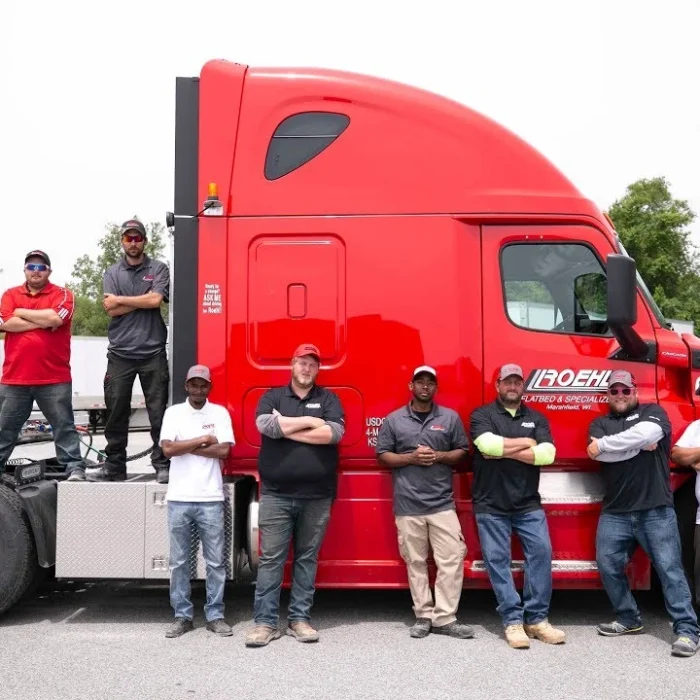4-12 Weeks to get a cdl
Obtaining a Commercial Driver’s License (CDL) as professional driver opens the door to a rewarding career in the transportation industry. But, how long does it take to get a CDL? Usually 4-12 weeks.
In this article, we’ll explore the process of obtaining a CDL for commercial truck drivers, the factors that influence the timeline, and the steps to take to ensure a smooth journey toward your goal.
You can find the full CDL training guide here.

CDL Overview
Types of CDLs
There are three types of CDLs: Class A, Class B, and Class C. Each class has different requirements and permits the operation of specific types of commercial vehicles.
Choosing the right license class for of commercial vehicle also depends on the type of vehicles you plan to drive and the specific job opportunities you’re targeting.
CDL Requirements
To apply for a CDL, you must meet the following requirements:
Be at least 18 years old (21 years old for interstate driving)
Possess a valid driver’s license
Pass a medical examination
Provide proof of residency and identity
Pass the written and skills tests

CDL Timeline
CDL Preparation
Before taking the written and skills tests, you’ll need to study the full, CDL exam and drivers’ manual and possibly enroll in a training program whilst you will have a commercial learner’s permit, this won’t allow you to drive a semi truck. The time it takes to prepare for the written exam and tests varies, but most people spend 2-4 weeks studying and practicing.
Written Tests
The written tests consist of a general knowledge test and specific tests for each type of commercial motor vehicle, or endorsement you seek. Most states allow you to take the tests on a walk-in basis, and the tests typically take 1-2 hours to complete.
Skills Test
After passing the written tests, you’ll need to schedule a skills test, which includes the testing schedule a pre-trip vehicle inspection, basic control skills, some driving hours and an on-road driving test. The skills test takes about 2-4 hours to complete.
Below is an expanded list of the top 10 highest paying trucking companies with approximate yearly salaries and information on work hours. Keep in mind that work hours may vary depending on factors such as route, freight type, and company policies.
Walmart Transportation
- Average yearly salary: $75,000 to $90,000
- Work hours: Walmart drivers typically work full-time, with regional and local routes that allow for regular home time. The company aims to provide predictable schedules and consistent hours.
Sysco
- Average yearly salary: $65,000 to $85,000
- Work hours: Sysco drivers generally work full-time and have local or regional routes, which means they can expect regular home time. Some positions may require early morning starts or occasional weekend work.
Old Dominion Freight Line
- Average yearly salary: $60,000 to $80,000
- Work hours: Old Dominion drivers usually work full-time, with various shifts available, including day and night. Many positions offer regular home time, although some regional or long-haul routes may require longer periods away from home.
UPS
- Average yearly salary: $60,000 to $75,000
- Work hours: UPS drivers typically work full-time, with shifts that can vary based on route and package volume. While many drivers enjoy regular home time, peak seasons may require additional hours or weekend work.
FedEx
- Average yearly salary: $55,000 to $75,000
- Work hours: FedEx drivers generally work full-time, with varying shifts and routes. Many positions offer regular home time, but long-haul or regional routes may require extended periods away from home.
YRC Worldwide
- Average yearly salary: $55,000 to $70,000
- Work hours: YRC Worldwide drivers often work full-time, with different shifts and routes available. Local and regional positions typically offer regular home time, while long-haul drivers may spend more extended periods on the road.
J.B. Hunt Transport Services
- Average yearly salary: $50,000 to $80,000
- Work hours: J.B. Hunt offers a variety of driving positions, with work hours that can vary based on route and job type. Many positions provide regular home time, but some regional or long-haul roles may require longer periods away from home.
XPO Logistics
- Average yearly salary: $55,000 to $75,000
- Work hours: XPO Logistics drivers typically work full-time, with a range of shifts and routes available. Local and regional positions often allow for regular home time, while long-haul drivers may spend more time on the road.
Schneider National
- Average yearly salary: $50,000 to $75,000
- Work hours: Schneider National drivers usually work full-time, with various shifts and routes to choose from. The company offers positions with regular home time, as well as regional and long-haul opportunities that may involve longer periods away from home.
Con-way Freight
- Average yearly salary: $50,000 to $70,000 (before acquisition by XPO Logistics)
- Work hours: Before the acquisition by XPO Logistics, Con-way Freight drivers generally worked full-time, with a variety of shifts and routes available. Many positions offered regular home time, although some regional or long-haul roles required extended periods on the road.

Factors Affecting CDL Timeline
Individual Factors
How long does it take to get a CDL varies depending on factors such as your prior driving experience, your ability to learn and retain information, and your availability to dedicate time to studying and practicing.
External Factors
External factors, such as waiting times for testing appointments, can also impact the your CDL test timeline. Keep in mind that factors like weather conditions or staffing shortages might cause delays in scheduling your skills test.
Accelerated CDL Programs
Some schools offer accelerated CDL training and testing programs that can help you get your CDL in as little as 3-4 weeks. These programs typically include about seven weeks of intensive training and support to ensure you’re well-prepared for the tests.
CDL Endorsements
If you’re seeking additional endorsements (such as Hazmat, Passenger, or School Bus), you’ll need to pass additional written tests, road test, and, in some cases, skills tests and practice driving them. This can add time to the overall process, depending on how quickly you can prepare for and pass these tests.

CDL Training For a Professional Truck Driver
Types of Training
There are various types of CDL training programs, including self-study, online courses, and in-person training at driving schools or community colleges. The type of training you choose and how many driving hours will affect the time it takes to get your CDL.
Choosing the Right Training
When selecting a CDL training program, consider factors like cost, location, and program length. Be sure to research the school’s reputation, job placement rates, and the quality of the instructors to ensure you’re making the best choice.
Maintaining Your CDL
Once you’ve obtained your CDL, it’s essential to maintain a clean driving record and stay current with any changing regulations. Periodic medical examinations and renewal of endorsements may be necessary, depending on your state’s requirements.

Truck Driving School
Benefits of Attending a Truck Driving School
Attending a truck driving training school can be a valuable investment in your career. The benefits of enrolling in a reputable truck driving or licensed driver training school include:
Structured Curriculum: A truck driving school provides a structured learning environment, with a curriculum designed to cover all aspects of obtaining a CDL, including vehicle operation, safety, and regulatory compliance.
Experienced Instructors: Professional instructors at truck driving schools have extensive experience in the industry, and they can share valuable insights and tips to help you succeed.
Hands-On Training: One of the most significant advantages of attending a truck driving school is the opportunity for hands-on training with the type of vehicle you’ll be operating, dump trucks, straight trucks, box trucks and other cdl classifications. This practical experience is an essential cdl process for building confidence and improving your driving skills.
Job Placement Assistance: Many truck driving schools offer job placement assistance to help graduates find employment in the transportation industry. This can be a valuable resource, especially for those new to the field.
Networking Opportunities: Attending a truck driving school allows you to meet and network with other aspiring drivers, which can lead to friendships, support, and potential job opportunities. Trade school opportunities for further training and perhaps tank vehicle endorsement, hazardous materials endorsement, hazmat endorsement. CDL schools tend to have cdl program for further endorsement.
Choosing the Right Truck Driving School
When selecting a truck driving school, it’s crucial to consider the following factors regarding trucking schools:
Accreditation and Licensing: Ensure the school is accredited and licensed by the appropriate state and industry organizations. This can be an indicator of the school’s quality and commitment to professional standards.
Program Length: The length of the program can vary, with some schools offering accelerated courses, while others may have longer, more comprehensive programs. Consider your schedule and the time you can dedicate to training when choosing a program. For busy trainees part time programs are also a better choice when compared with full time programs.
Cost: Truck driving school costs can vary significantly. Be sure to factor in tuition, fees, and any additional expenses, such as housing or transportation, when comparing schools.
Training Equipment: Check the school’s training equipment, such as trucks and simulators, to ensure they are up-to-date and representative of the vehicles you’ll be driving in your career. You want to be safe during road training and driving tests.
Student Reviews and Testimonials: Research the experiences of past students to get a sense of the school’s reputation and effectiveness in preparing students for the CDL exams and successful careers.
Attending a truck driving school can provide valuable training, hands-on experience essential knowledge, and resources for obtaining your CDL and launching a successful career in the transportation and trucking industry.

Benefits of a Commercial Driver’s License
Obtaining a Commercial Driver’s License (CDL) can unlock numerous opportunities and advantages in the transportation industry. Here are some key benefits of having a CDL:
Job Opportunities: A CDL opens the door to a wide range of employment opportunities in various industries, such as trucking, construction, and waste management. With a CDL, you’ll have access to numerous job openings that may not be available to those without a CDL.
Higher Earning Potential: CDL holders generally earn higher salaries compared to non-CDL drivers. With experience and additional endorsements, you can further increase your earning potential in specialized roles or by operating specific types of vehicles.
Job Security: There is a consistent demand for CDL drivers across the country, as the transportation industry plays a vital role in the economy. With a CDL, you’ll have a greater sense of job security, knowing that your skills are in high demand.
Travel Opportunities: As a CDL holder, you’ll have the chance to travel and see different parts of the country while on the job. For those who enjoy exploring new places, a career as a commercial driver can be both fulfilling and adventurous.
Flexible Schedules: Depending on the type of job and company you work for, you may have the option to choose between local, regional, or long-haul driving positions. This flexibility allows you to select a work schedule that best suits your lifestyle and preferences.
Independence: Many CDL drivers appreciate the independence that comes with their job, as they spend most of their time on the road and are responsible for their own schedules and route planning.
Career Advancement Opportunities: With experience and a strong work ethic, CDL drivers can advance in their careers, moving into roles such as dispatchers, trainers, or management positions. Some drivers even choose to become owner-operators, running their own trucking businesses.
Transferable Skills: The skills you acquire as a CDL driver, such as time management, customer service, and vehicle maintenance, are transferable to other industries and roles, providing you with a versatile skill set that can serve you well in various career paths.

Last Words For A Truck Driver
To become a licensed cdl driver, you must pass your class A cdl. So how long does it take to get a cdl? Expect the process to get a cdl to take anywhere from 4-12 weeks, with accelerated programs offering a faster path.
Keep in mind that class b cdl training programs and class c cdl will not allow you to drive a semi truck. Make sure to get the correct cdl license before becoming a truck driver.
By thoroughly preparing and staying organized, you can increase your chances of success and embark on an exciting new career in the transportation industry with your fresh cdl license.
Finally you can get more specific answers in your local dmv centre.

Frequently Asked Questions
Can I get a CDL if I have a criminal record?
It depends on the nature of your criminal record and the specific regulations in your state. Some convictions may disqualify you from obtaining a CDL, while others may not.
Do I need a CDL to drive a recreational vehicle (RV)?
In most cases, you do not need a CDL to drive an RV. However, some states require a special non-commercial driver’s license for RVs above a certain weight.
How often do I need to renew my CDL?
CDL renewal periods vary by state but are typically required every 4-8 years. Check with your state’s licensing agency for specific renewal requirements.
Can I use my CDL in another state?
Yes, a CDL issued in one state is generally recognized in all other states. However, you must transfer your CDL to your new state of residence within a specified time frame, usually 30-60 days.
What is the cost of obtaining a CDL?
The cost of getting a CDL varies depending on factors such as training program fees, testing fees, and endorsement fees. On average, expect to pay between $3,000 and $7,000 for a comprehensive training program.







